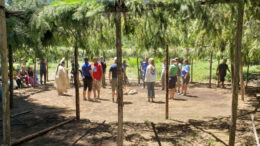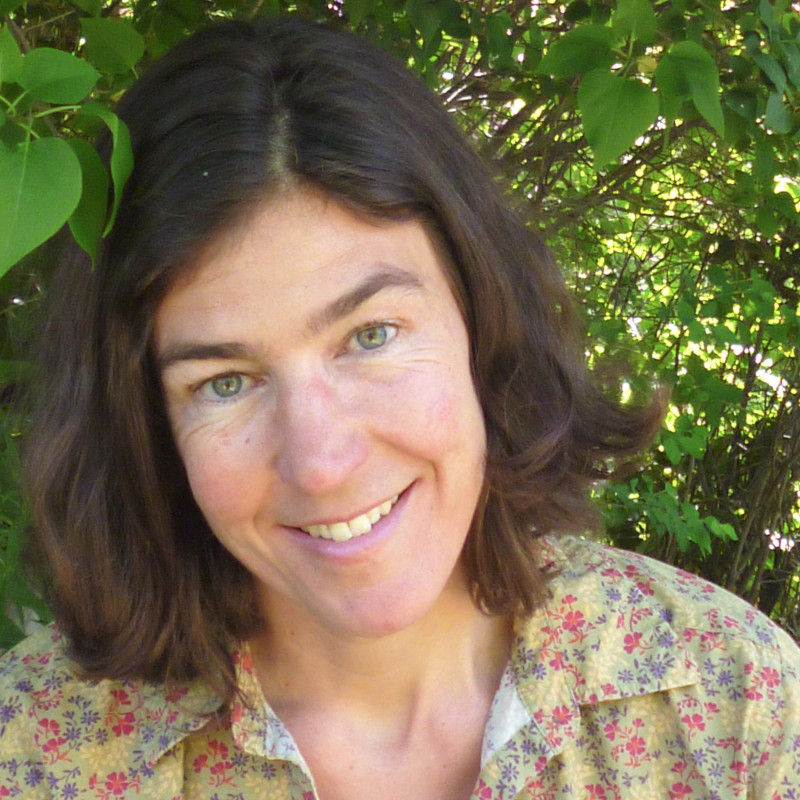Late in the morning on July 12, a helicopter landed in a field near the entrance to AhDiNa, a campground on the McCloud River in Northern California. Children ran ahead to greet the craft, and soon the road was lined with spectators waiting to witness the delivery of precious cargo: an insulated bucket containing 25,000 fertilized winter-run Chinook salmon eggs.
These eggs would not only bring the Winnemem Wintu Tribe one step closer to bringing salmon, or Nur, back to their ancestral waters, but could also help save the species from extinction.
Winter-run Chinook spawn in summer, but the spring-fed McCloud River runs cold all year round, buffering eggs and young salmon from even the worst summer drought. For 80 years the formidable Shasta Dam has blocked Chinook from the McCloud. Now fish are stuck in California’s Central Valley, where sizzling temperatures and water withdrawals make the Sacramento River lethal.
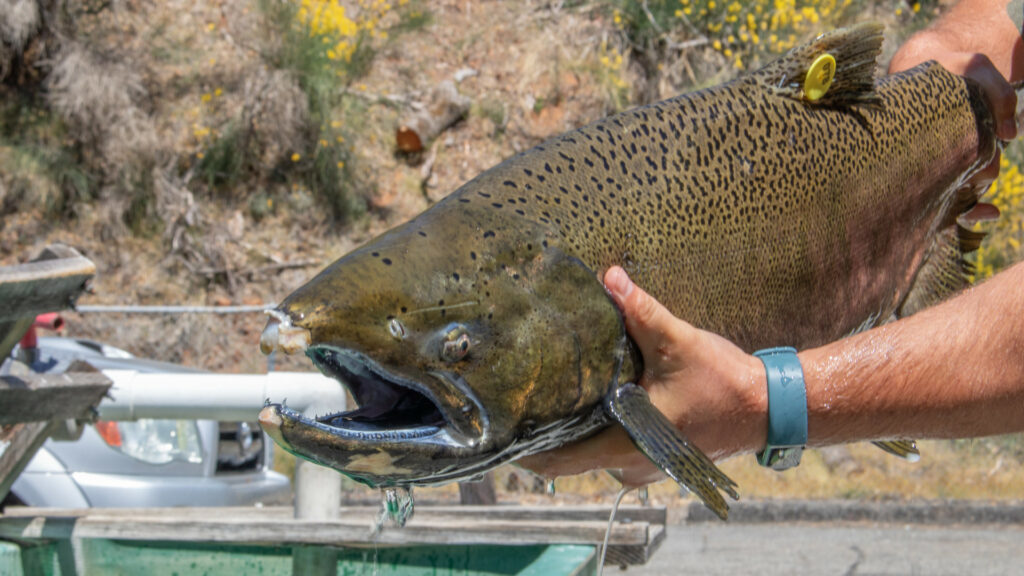
Winter-run Chinook eggs were first brought to the McCloud River last summer, as part of an emergency plan spearheaded by NOAA Fisheries, California Department of Fish and Wildlife, U.S. Fish and Wildlife Service, and the Winnemem Wintu to help the fish survive a third straight year of drought.
“We were flying by the seat of our pants,” says Cathy Marcinkevage, assistant regional administrator for NOAA Fisheries West Coast Region. “We had no idea what was going to happen last year. We had no idea if any of them would survive.”
The young salmon released into the McCloud River not only survived — they thrived, growing larger than those that reared in the Sacramento River below Shasta Dam.
Late last year the California Department of Fish and Wildlife captured and trucked 1,600 of the fry downstream so they could continue their journeys to the ocean. This year — with a new juvenile collection system, a novel streamside incubation system designed by the Tribe, and agreements in place that recognize the Winnemem Wintu as co-equal decision-makers — the partners hoped to build on their success.
Together Marcinkevage and Marine Sisk, fisheries supervisor for the Winnemem Wintu Tribe, carried the bucket to the ceremony grounds, a caravan of children and adults in their wake. Later in the afternoon, the partners would deliver the eggs to incubators on the riverbank.
First, it was time to dance the salmon home.
Warriors and Eggs
AhDiNa is at the end of a bone-juddering road south of the town of McCloud. On that July day, the campground was full of Winnemem Wintu, agency folk and their families, and people with Run4Salmon, a movement and prayer journey started by Winnemem Wintu Chief Caleen Sisk in 2016 to call salmon home to the McCloud River.
The ceremony took place in a circular arbor made from wood poles and conifer boughs. A fire in the center burned throughout the day, and as the sun rose higher, the circle had to be sprayed with water before the barefoot dancers could enter.
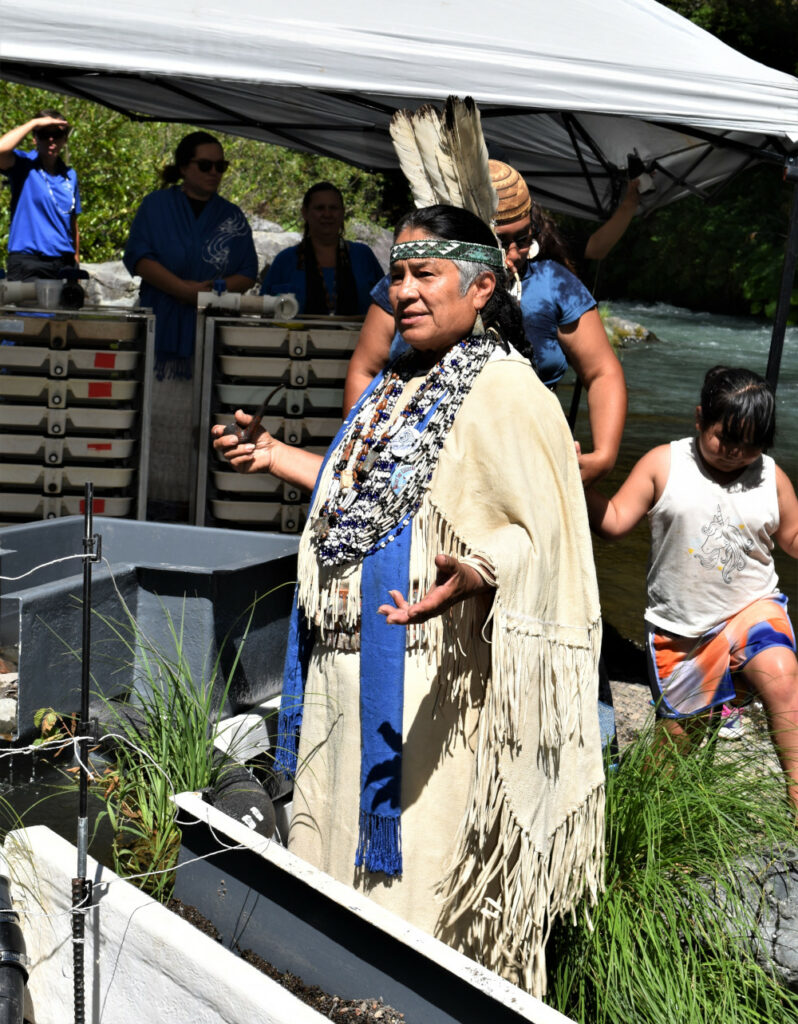
Between dances Chief Sisk invited partners from the agencies and organizations to join her in the circle. While a tribal member blew sage on each person, Chief Sisk asked the partners to open their hearts and minds and pressed for her two most urgent goals: building a “fishway” around Shasta Dam and bringing salmon, or Nur, from New Zealand back to the McCloud River.
Chinook eggs from the McCloud River were exported to New Zealand in the early 1900s, where runs formed in streams on the South Island. In 2010 Māori tribal members invited the Winnemem Wintu to come to New Zealand and see the fish, who Chief Sisk believes are the true relatives of McCloud River Nur.
In their agreements NOAA Fisheries and the California Department of Fish and Wildlife have vowed to work with the Tribe to determine whether Nur can be safely imported from New Zealand to California and reintroduced in the McCloud River. Both the state wildlife department and the U.S. Fish and Wildlife Service would have to sign off on the plan. Some of the questions they will need to answer: Would the fish bring new pathogens to the McCloud? Would they compete with the other reintroduced Chinook for the same resources?
“Bringing the fish back to the U.S. doesn’t necessarily fulfill the recovery objective that we have for winter-run because, to our understanding, [the New Zealand fish] are not genetically the same as the winter-run Chinook that we have now and are trying to recover,” says Marcinkevage. “But we understand they are culturally significant fish for the Tribe and there’s probably a feasible opportunity to have a dual reintroduction that would support both of these species.”
Chief Sisk says that if it weren’t for regulatory barriers, the Māori could deliver 20,000 fertilized eggs as early as next year.
“Some of the rules are wrong for salmon, and they need to be changed,” she says.
For now the eggs come from U.S. Fish and Wildlife’s Livingstone Stone hatchery on the Sacramento River. To the people gathered at AhDiNa, they were still worth celebrating.
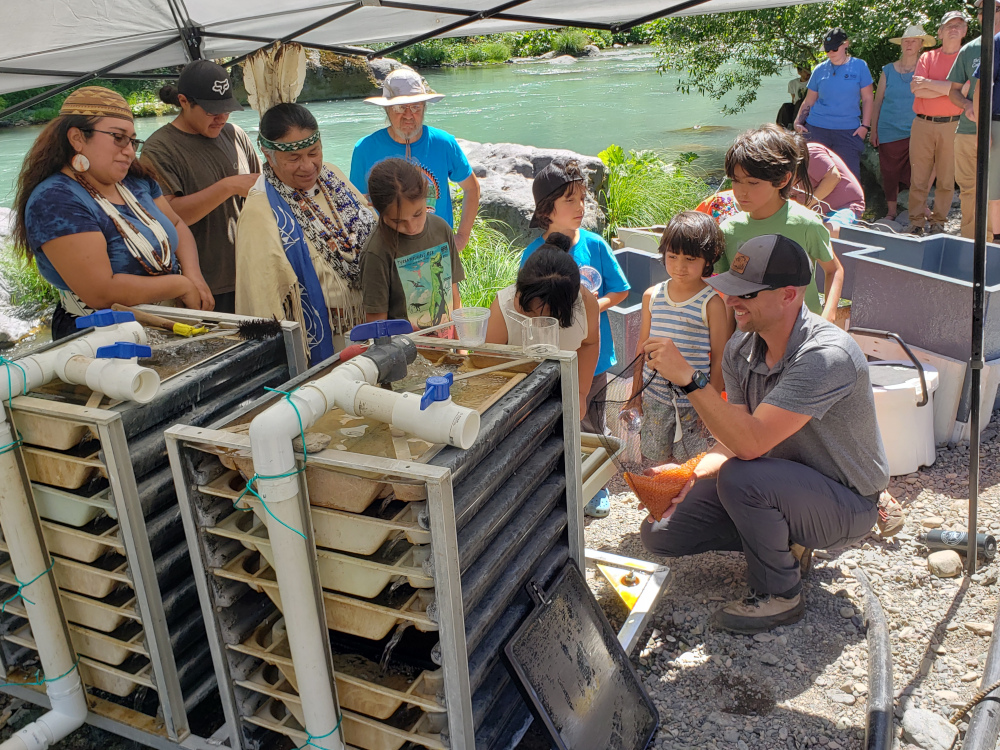
The Salmon Dance was the last dance of the ceremony. While the women sang and men drummed, two dancers entered the circle, stepping lightly, undulating like fish. Next came a pair of warriors, their steps more emphatic, underscored by the clatter of anklets. A fifth dancer weaved in and out of the others.
The fifth dancer was the Salmon Spirit, dance captain Rick Wilson explained. First he dances with the salmon and thanks them for presenting themselves. Then he dances with the warriors in the same style.
“He makes sure they’re doing it for the right reason,” says Wilson. “He’s saying, ‘It’s okay; you’re good to go.’ ”
Stronger, Faster, Larger
Down by the river after the ceremony, a small crowd of adults and children pressed around a shade structure, where two vertical stacks of trays were set up. A pipe trickled water continuously through the stack. Each tray can accommodate thousands of salmon eggs. Used in virtually all hatcheries, the system is an efficient if unnatural way to grow fish.
Adjacent the shade structure was a second incubator system designed by Chief Sisk and built with the help of scientists from UC Davis.
Chief Sisk doesn’t like how the fry in the hatchery trays are stacked on top of each other; she wants them to have access to gravel and more agency. Her system, called the Nur Nature Base, has a much larger footprint than the hatchery trays and resembles a backyard water feature. Two deep square basins, lined with gravel, connect to a central pool that is planted with rocks and willow shoots. A sloping chute leads from the pool to a shallow, cobble-lined basin alongside the river.
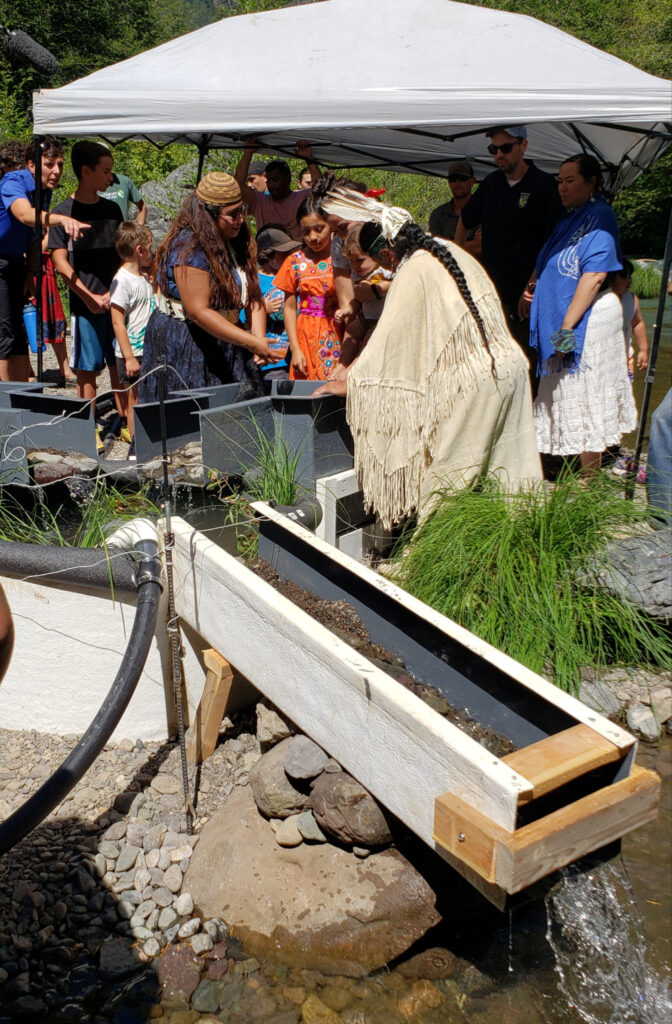
Once the eggs hatch, the fish can swim over the lip of the basin into the pool, Chief Sisk explained to the crowd. “And when they’re ready, they’ll swim into this side channel, which the Winnemem Wintu have always built.”
Children crowded around Chief Sisk and her daughter, Marine, waiting for their turn to scoop cups of the orange, BB-sized eggs into the hatchery trays, then into one of the basins of the Nur Nature Base. By the time they completed the task, there were 11,000 eggs in the hatchery trays and 14,000 in the Nature Base.
Chief Sisk is confident that the Nur Nature Base will give the young fish a jump-start. “They’ll be stronger, faster, and larger,” she says.
In a few years, the team will know if she’s correct. Because the fertilized eggs come from the hatchery, the scientists know the identities of their parents and have segregated eggs from unique families between the hatchery trays and the Nur Nature Base. This way any fish that survive and return to the Sacramento River as spawning adults can be genetically traced back to one of the two rearing systems.
Eggs were delivered again in late July and early August, for a total of up to 80,000. Using two different systems and three simulated spawning dates will help the partners learn which strategies work best.
“We’ll know and learn better ways of setting up rearing and incubation,” says Rachel Johnson, salmon life history program lead for NOAA Fisheries Southwest Fisheries Science Center. “What I also love is we are braiding natural science with spiritual and culturally relevant practices.”
Later this summer, the state wildlife department and the Tribe will place a rotary screw sampling trap downstream so they can estimate the number of fry that make it downstream. The agency also hopes to test an experimental in-river fish-trapping station where the McCloud River fattens into an arm of Shasta Lake. Finally, the California Department of Water Resources will install its Juvenile Salmonid Collection System to catch any fish the other traps miss. The system, which the agency piloted last year, uses cold water to funnel young salmon to a collection point, where they can then be trapped and transported below the dam.
Though this is the first project to reintroduce salmon to historical habitat above a large dam in California. Marc Commandatore, environmental program manager at the Department of Water Resources, says the winter-run project is “just the beginning.”
NOAA Fisheries has identified reintroducing fish to high-elevation tributaries as a key climate resilience strategy, especially for salmon languishing in the Central Valley.
“Fish are in the frying pan in the valley,” says Commandatore. “They want to be this beautiful cold water.”
The partnership with the Winnemem Wintu is also a welcome sign of new respect and collaboration among Western scientists and the region’s original salmon stewards. “To bring tribal knowledge into decision-making…I’m humbled by it,” says Commandatore. “We wouldn’t be here if science and engineering and belief hadn’t all come together.”
Previously in The Revelator:
https://therevelator.org/lifeline-winter-run-chinook/

